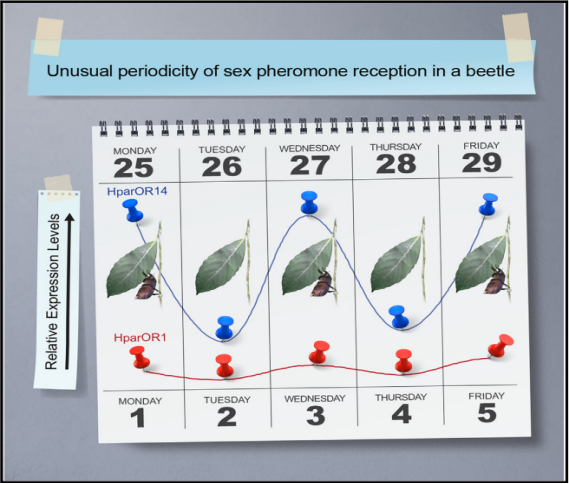Research on the circabidian rhythm of sex pheromone reception in a scarab beetle
Recently, a study published in the journal Current Biology unveils the unusual biological rhythm of the large black chafer beetle, Holotrichia parallela, an agricultural pest in Asia. The study by researchers at Institute of Plant Protection of CAAS (IPPCAAS), Northeast Normal University and University of California, Davis shows that the male beetles' ability to detect female pheromones is on a 48-hour, or circabidian, cycle.
Twenty-four hour rhythms in physiology and behavior are commonly observed in organisms from bacteria to humans, but 48-hour rhythms as Holotrichia paralllela in nature are rare. To determine whether this circa’bi’dian rhythm affects the olfactory system, we cloned 14 odorant receptors (ORs) and HparOR14 in the Xenopus oocyte recording system gave robust responses to sex pheromone LIME. Structural modeling, tissue expression profile, and RNAi treatment followed by physiological and behavioral studies support thatHparOR14 is a sex pheromone receptor- the first of its kind discovered in Coleoptera. The HparOR14 transcript levels throughout the adult’s life showed that gene expression was significantly higher in sexually active days (31-51d) . Additionally, the HparOR14 expression profile and electroantennogram recordings confirms that the male chafer beetle’s ability to detect female pheromones operates on a 48-hour circabidian cycle, aligning with the females’mating behavior. This study identified the sex pheromone receptor HparOR14 in Coleoptera for the first time and help to elucidate the peripheral olfactory molecular mechanism of sex pheromone recognition, and in application, provide a theoretical basis and key genetic targets for the use of sex pheromones for accurate monitoring of ontogenetic adults, mass trapping in the field and interference with mating behavior.
This research was supported by the the National Key R&D Program of China, the National Natural Science Foundation of China, and the Natural Science Foundation of Beijing, China.
Link: https://www.sciencedirect.com/science/article/pii/ S0960982223017578

-
 China-Laos Training Workshop on Integrated Management of Destructive Crop Pests and Diseases Successfully held in Laos
China-Laos Training Workshop on Integrated Management of Destructive Crop Pests and Diseases Successfully held in Laos -
 New Plant Protection: New challenge and new opportunity for plant protection
New Plant Protection: New challenge and new opportunity for plant protection -
 International and SELAMAT Conference on Pesticide Residue and Mycotoxin Contamination Held in Beijing
International and SELAMAT Conference on Pesticide Residue and Mycotoxin Contamination Held in Beijing -
 CAAS President Meets Chairman of ASEAN FAW Taskforce
CAAS President Meets Chairman of ASEAN FAW Taskforce
